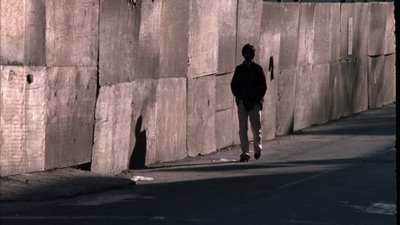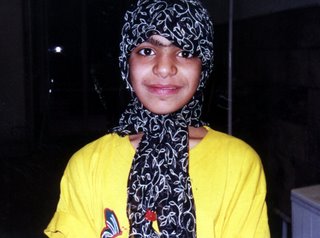 The SFIFF is coming up on its midway point, and I've been availing myself of its varied opportunities, whether to stargawk at Factotum's Matt Dillion or to try to wrap my head around the Wayward Cloud. To briefly catch up on the press screenings I've been able to attend, I found Ricardo Benet's SKYY Prize contender News From Afar (which plays Apr. 29 and May 2) to be a very worthy and cinematic drama, constrasting the desolate beauty of a drought-plagued region of rural Mexico against the visual poverty of a gray and oppressive Mexico City. The documentary Favela Rising (plays Apr. 29 and May 1), on the other hand, fails to wade through its own audiovisual disorganization to show us more than snippets of its subject, Rio's socially-constructive musical group AfroReggae. And this morning I caught another doc, Adrian Belic's Beyond the Call (plays Apr. 30 and May 4), which I thought could have benefitted from some context beyond its narrow focus but still successfully parachuted me into the world of these three humanitarian adventurers for 82 minutes.
The SFIFF is coming up on its midway point, and I've been availing myself of its varied opportunities, whether to stargawk at Factotum's Matt Dillion or to try to wrap my head around the Wayward Cloud. To briefly catch up on the press screenings I've been able to attend, I found Ricardo Benet's SKYY Prize contender News From Afar (which plays Apr. 29 and May 2) to be a very worthy and cinematic drama, constrasting the desolate beauty of a drought-plagued region of rural Mexico against the visual poverty of a gray and oppressive Mexico City. The documentary Favela Rising (plays Apr. 29 and May 1), on the other hand, fails to wade through its own audiovisual disorganization to show us more than snippets of its subject, Rio's socially-constructive musical group AfroReggae. And this morning I caught another doc, Adrian Belic's Beyond the Call (plays Apr. 30 and May 4), which I thought could have benefitted from some context beyond its narrow focus but still successfully parachuted me into the world of these three humanitarian adventurers for 82 minutes. The SFIFF can't be beat this week and next in terms of variety and in-person appearances, but Frisco theatres have stepped up with some formidable counter-programming. The Red Vic has the City of Lost Children tonight and the Passenger Sunday-Monday. The Lumiere has the Fallen Idol for a week starting Friday. The Castro has booked a Stanley Kubrick series this Saturday-Wednesday. And on Monday night before heading to the Edinburgh Castle for International Remix I dropped in to see Barbary Coast, playing as part of the Balboa's Reel SF series that ends tomorrow.
On Friday the Balboa will be starting a week-long run of Kim Longinotto's latest documentary Sisters in Law. (It's the kickoff of the brand-new Balboa calendar spotted around town, which also includes Mongolian Ping Pong starting May 26, a massive Boris Karloff tribute starting June 2, and Jean-Pierre Melville's Army of Shadows starting June 23.) I've never seen a Longinotto film before, but my friend and now three-time contributor to this blog, Adam Hartzell has seen several, thanks to the Pacific Film Archive (which incidentally has released its newest calendar, too). Here's Adam:
The day after booking my recent vacation itinerary, I realized my work had a vacation day the Friday of the week I returned. Immediately I kicked myself, because if I'd have known, I could have scheduled to spend more time in Bangkok visiting the Thai Film Archive under the guidance of my friend Noy Thrupkaew and I could have spent more time at the entire Women's Film Festival in Seoul (WFFIS) rather than just the first half. I eventually felt better when I realized my early return would enable me to see five of the films with Kim Longinotto at the Pacific Film Archives (PFA) that I have yet to see. An added extra was that the jetlag that was keeping me up until 3am came in handy for the 9pm screenings that my up-at-5am work life normally has me struggling to keep my eyes open through. Plus, this enabled me an opportunity to give Longinotto a copy of the WFFIS's program that the film she co-directed with Florence Ayisi, Sisters In Law, opened. Longinotto, much to my appreciation, greatly appreciated this gesture since she hadn't received a program yet from that festival.
As part of their Documentary Voices series at the PFA, curator Kathy Geritz was able to procure films with and attendance of Kim Longinotto as she travels throughout the United States promoting the release of Sisters In Law, the film she directed along with Florence Ayisi. Let me now clarify why I'm using the preposition 'with' rather than 'by', i.e., "films with Kim Longinotto". Longinotto sees her films as collaborations with all involved in the making of the film. More so, when she is working in a language other than English where a translator friend is such an active part of the filmmaking process, she feels uncomfortable in crediting only herself as the director. So she credits as co-directors those who have assisted her in filming via their tireless translation. (In the case of The Day I Will Never Forget (2002), a film I did not see about female circumcision, there were so many women assisting with filming and translating that it became indexically cumbersome to credit each one.) This respect for those working with her carries over to the compassion conveyed towards those individuals who agreed to have these intimate moments of their lives portrayed on screen.And intimate moments they are when we consider how much about Iran's day to day lives are kept from us, particularly from my fellow U.S. citizens presently as the prophet-complexed administration mis-ruling our country and their complicit media forces seek to justify their desire to bomb Iran because they have the most toys. The powers that corrupt know that if we were to touch on the daily lives of those they fiendishly desire to bomb, we would be even more unwilling to allow such an atrocity to happen than we already are. Both Divorce Iranian Style (1998) and Runaway (2001), each co-directed with Ziba Mir-Hosseini, allow us an opportunity to follow snippets of the lives of Iranian women as they wrestle with limitations in self-definition that the Iranian government imposes upon them. I think I have missed three opportunities to see Divorce Iranian Style and I was thankful to the PFA for providing me yet another chance. Under the Iranian government's interpretation of Islamic Law, a man can divorce his wife without cause, but a woman must have her husband's consent or prove his impotency, insanity, or financial instability. Longinotto and Mir-Hosseini follow the goings on in one particular family courtroom. Unhappy in their marriages for various reasons, we witness several women try to negotiate their way out of these relationships. We witness them plead, demand, haggle, acquiesce, confess and lie to the judges to find liberation from their societal constraints.
Several moments stand out during this powerful documentary. When the judge is asked by a 16 year-old who was married as a 14 year-old to a man who looks like he's in his mid-30's, at what age can a girl be legally married, one can see the serious discrepancies between the written, literal law and the law that feels right when he answers by saying she can be married when she reaches puberty, which can be as early as 9. Longinotto elaborated how she found the judge to be a sensitive, kind man who was often in conflict with the literal law and the unique situation each plaintiff presented. This is why Longinotto and Mir-Hosseini included images of him praying in between cases, because the judge would often need such moments of reflection after all the unsettling matters he must settle.
An Iranian friend of mine whom I told about this moment in the film provided a hopeful story that presents an Iran not as beholden to fundamentalism as is often presented to us. When a friend of hers returned to contest a land dispute, he found himself in a courtroom with a plaintiff who decided to simply read from the Koran, regardless of relevance to the case at hand, to demonstrate he is the more faithful Muslim over that of my Westernized friend's equally Westernized friend. The judge, a mullah like the judge in Longinotto's film, responded with utmost diplomacy, calling out the tactics of the plaintiff as insincere while still showing respect for the Koran by saying something along the lines of 'We appreciate your gesture, but in this court we don't trust those who quote the Koran a lot.' If only we saw more of that judge's emerging Iran in the corporatized U.S. media.
Or if only we saw more of the younger Iranian generation coming up, such as the young girl who is the daughter of one of the female clerks who comes to the court after she finishes her school day. There is a powerful moment in the film when she gets up onto the bench, demands silence, and proceeds to hold court by providing the most astute commentary provided throughout the whole film. She questions the make-believe real men in front of her, asking them why they are not kinder and more respectful of their wives. Never has the cliché 'out of the mouths of babes' been more poignant as this moment where a child presents a better understanding of the women's view than the male judges or female plaintiffs seem to at times.Runaway follows younger women who, like the older women (although some not that much older, some even younger) seeking divorce, have left their homes for various reasons, often because of abuse by parents or siblings. These runaways seek refuge in a shelter run by women where they can avoid the dangers of the street while efforts are made to re-connect these girls with their families. Although there appear to be avenues for the girls to escape from extremely violent or otherwise detrimental homes, the primary mission appears to be to eventually reconnect these girls with their respective families. One of the interventions involves telling the girls boogeyman stories about the violence that can happen to them out on the street. I'm sure these stories have some truth to them, but I would hope for greater feminist advocacy in this women's space than reinforcement of the patriarchy. A particularly harrowing moment is when an obviously drunk (or high) greatly older brother seeks to advocate for his sister's return as the mother and sister stand silent. The child appears quite discomforted by the scene. Later when she engages in a quick turnaround professing excitement to return home, serious doubts arise over this young girl's future. But the shelter workers have no other recourse outside of getting no-violence guarantees signed, since the law is clearly geared toward keeping families together even if detrimental to individual lives within those families.
Kim Longinotto's commentary before and after the screenings was the best I have heard in recent Q&As. I resoundingly concur with Lys Woods at Synoptique who notes Longinotto's "completely winning persona." Longinotto truly added a great deal to the experience of the viewings, offering fascinating asides, such as her respect for the judge and how they captured the powerful moment of the child playing judge in Divorce Iranian Style. Apparently the child was quite precocious, greatly wanting to be filmed. Longinotto and Zir-Hosseini tried to explain that they wanted to capture a moment as it happened, not something planned. Whether or not the young girl planned the moment at the judge's bench, she saw her moment when Longinotto and Zir-Hosseini finally captured the judge leaving. Confidently striding up to the bench, pounding her tiny, opened hand, she held court for future Iranians should they survive the lethal politics of the Cheney/Rove administration, as, if not clear enough already, I very much hope they do.
The first film Longinotto co-directed, Pride of Place (1976, co-directed with Dorothea Gazidis and where Longinotto is credited as 'Kim Longinotto Landseer', 'Landseer' being a name her father attached to falsely claim that they were related to the famous painter), involved returning to her public (what would be called a private school in the U.S.) boarding school in England. Encouraged by financial necessity to film in black and white, the economic resourcefulness brought an appropriate feel to the dingy, dark, hopelessly unnecessary feel of the school. When we see the headmistress yet again get nasty with the 'stupid' girls, telling them how they have wasted 10 or more minutes on locating someone's blazer, I wanted to scream out at the headmistress, 'No, lady, YOU are the one wasting time!' The girls seem to learn more during their chatting sessions around the classes than studying anything in class. In her commentary, Longinotto spoke of how she admired the rebels she found while filming, and it was the smoking in the woods scene that brought the rare smile found on my face while watching this film, my face otherwise resorting to contorting a grimace at how horrible, or a guffaw at how ridiculous, all the scolding was.An interesting aspect of Longinotto's commentary was that it provided emotional balance for me. After the two Iranian films, I found myself seeing rows of half empty glasses, lacking the hope I saw after the documentaries done in Japan. But Longinotto reassured me and the audience that there were women doing some amazing work within the constraining parameters. Equally, my half-full glasses were toppled somewhat by the additional information Longinotto provided regarding the documentaries made in Japan.
Dream Girls (co-directed with Jano Williams, 1993) follows the immensely popular Takarazuka Music School and Theater where the Japanese women reverse the Kabuki rule of men playing women characters. Here the women play women and men, and the women playing men are the most avidly followed by women audiences that sell-out most shows. We follow the hazing rituals of the first year that consists of OCD-esque cleaning rituals, walking around the room close to the walls, and opening the door ever so slightly to slip through. I must say that I was a bit prone to find rebellion where others might not in the actors on stage and in the audience watching them. I have been concerned about the recent denigrating commentary about the Japanese housewife fans of "Yonsama", South Korean actor Bae Yong-joon of "Winter Sonata", a South Korean TV serial immensely popular throughout Asia. Rather than showing teenage regression amongst these women fans of both Yonsama and the Takarazuka Theater, I'm wondering, when explored in-depth rather than from tired journalistic frames, if we might find something similar to what Barbara Ehrenreich, Elizabeth Hess, and Gloria Jacobs found in their essay "Beatlemania: Girls Just Want To Have Fun", arguing convincingly that "Beatlemania" provided a sexual outlet for emerging women whose society placed all responsibility for state-sanctioned chastity on them rather than their male counterparts. The de-individuation of the group permitted a space where a young woman "...who might never have contemplated shoplifting could assault a policeman with her fists, squirm under police barricades, and otherwise invite a disorderly conduct charge" (The Audience Studies Reader, Will Brooker and Deborah Jermyn, p. 183). In the case of Dream Girls, might these fans and participants relish this space to expand beyond the gender roles they are confined within, where, for a moment, the women can have the privileges of men and these women as men can both caress and romance the women as they desire to be caressed and romanced? Might these women simply need a space away from men portraying men where they can talk amongst themselves about feelings and thoughts they feel they must hide elsewhere? And to bring this closer to my home, might we find similarities between Japanese housewives and their 'hysteria' for Yonsama and the male players of the Takarazuka Theater and the popularity of "Desperate Housewives", most significantly popular in the States where sexually- and gender-repressing Christian Dominionists have the greatest sway? Repressing people's healthy desires leads to projection on some object and the de-individuation of the mob - so wonderfully outlined in the essay "My Crowd: Or, Phase 5: A report from the inventor of the flash mob" in the March 2006 issue of Harper's Magazine by Bill Wasik - allows for un-self-conscious release of that which is not permitted release elsewhere by society.
Longinotto, and astute audience members, put a bummer on my progressive buzz by reminding me of a few items the film notes. First off, the Takarazuka Music School and Theater was created, choreographed, and overall ruled by men. Second, it is these ruling men who have set the rule that each 'top star' (only a male role-player can be a 'top star') is only permitted a two year reign so as to reign in any feminist ideas she might get in her head from being a he for any longer. Not so ironically, male role-players are mythed within Japanese culture as desirable wives because they 'know' what it's like to be a man. So this most progressively possible of projects still ends up feeding the patriarchy's needs. Still, such spaces won't necessarily stay completely confined within the rules set by others. Gradually women demand similar freedoms men demand from the exhilarations provided by such alternative spaces. Some of them will go back to their home lives and enact positive changes of varying degrees through the inspiration provided by their top star muse.
All this could perhaps better explain the recent cultural shift in Japan that is unnecessarily disparagingly described as para-chan or "parasite singles", (a disparaging moniker chosen by a male sociologist, nonetheless). The phenomenon has been too often discussed as a 'problem' and the focus of this 'problem' has too often been mis-placed on the women alone rather than the political/economic/social factors that make it difficult for a single women to find work, a reasonable rent, and fulfilling relationships in Tokyo. Their only options are either staying with their parents or shacking up with a man to survive. (And in those latter cases, why aren't the men referred to as 'para-chans' since it can be well argued that the men are parasitic in their living off the unpaid labor of their wives? Yeah, we know why male sociologists never think of their fellow men that way.) For those women who want a job and relationship just like men, (or those women who find Japanese society too restrictive to allow for the open Lesbian relationship they desire), staying with their parents seems more palatable than solely tending house for a man they are less than happy with. The dreamspace provided by the Takarazuka Music School and Theater in Japan can't help but seep into our waking worlds as well. Could the phenomenon of Women Alone with Parents - allowing for a non-judgmental, thus more appropriate, term to describe this phenomenon in Japan - be the reasonable depressive response that follows the manic highs of the possible freedoms the Takarazuka Theater envisions? Could this just be the natural slacking when your hopes are squelched for a moment by economic and social inequality?
And might not that hope be found again in ones later years? Such as the hope I found in The Good Wife of Tokyo (co-directed with Claire Hunt, 1993). Kazuko Hohki is a Japanese woman living in Tottenham, England for over 15 years who has returned to her home with her three-person, art rock band Frank Chicken. (Recall David Byrne of the Talking Heads in his oversized suit chopping his forearm with his other hand while commenting on how this is not his beautiful house and tell him this is not his oversized suit either, take it off of him, and then put him in a skyscraper costume and make him sing and chant about the Rockefeller Tower being purchased by the Japanese. That is Frank Chicken.) Turns out Hohki's mother is quite an alternative performer as well, being a leader (with limits, which I'll get to later) in the House of Development, a Japanese mélange of Shinto, Buddhist, Christian, and Tony Robbinsist religions, a congregation of which she runs from her home. We see Hohki's mother minister to her disciples through their laughter and pain as her retired husband reads upstairs and Hohki remembers why she left Japan. I found both Hohki and her mother resilient souls who negotiated different spaces for similar needs to express themselves. Longinotto somewhat tempered the hope I found by adding that the House of Development is run by men and they are the ones who put a stop to Hohki's mother's special leaflet dance displayed during the credits. Plus, Longinotto underscored the moments in the film where Hohki's mother advocates acceptance of a women's plight advised by much of the House of Development's tenets that raze the more fulfilling houses that would otherwise develop were we left to negotiate homes that allowed for more gender equality.What Longinotto's commentary on both perspectives of the quintessential glass of half water underscores is that each of her films are full of more than we think, positively and negatively. So when those of us in San Francisco head out to see Sisters In Law at the Balboa after eating the fabulous food at the Shanghai Dumpling King and then contemplating the rulings of the Cameroonian Judge Beatrice Ntuba and what they mean for women, men, Muslims, Africa, and the world over coffee at Cafe Zephyr across the street afterwards, keep in mind there is so much more to this story than we will ever know. (Just as there's so much more to enjoy about The Richmond District than the three establishment shoutouts I've made.) We just can't stop with this documentary in hearing, seeing, and experiencing more about our mutual worlds. Longinotto isn't going to stop making these films with women, and I don't see myself ever getting tired of watching them.








0 Yorumlar